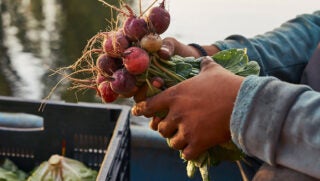The Purdue Ag-Celerator Fund is investing $100,000, and Ag Alumni Seed is offering a $100,000 matching investment in Rogo Ag LLC, a pioneering agricultural technology company that is developing autonomous robots to collect more accurate soil samples so farmers can make better decisions about distribution of fertilizers.
The startup’s primary technology, called SmartCore, is an autonomous robot developed by Rogo and is designed to collect accurate, repeatable soil samples in fields and return the samples directly to the farmer or growers.
“SmartCore can help farmers make more strategic decisions on fertilizer use and potentially reduce the amount of fertilizer they need to use, which reduces their costs,” said Troy Fiechter, Rogo co-founder and CEO. “It does this by getting the depth and location of each core of soil right.”
Fiechter and Drew Schumacher, Rogo co-founder and president, intend to use the funding for product goals such as simpler robot control, scalable bag labeling, and advanced collision avoidance. The startup also intends to continue scaling across the country, as well as innovate its technology further in the long term.
SmartCore uses a Bobcat skid steer chassis and navigates the fields using boundary algorithms and Lidar sensors, which send out laser light beams to detect objects. The operator only needs to identify trouble spots, such as ditches.
The autonomous robot collects samples through a hydraulic auger bit, which is configured so that no soil escapes the core, guaranteeing accuracy, purity, and depth control. SmartCore is able to return to each core every season using RTK GPS and navigational algorithms. Farmers can hire Rogo as needed.
Fertilizer costs are one of the biggest expenses that row crop farmers face. Inconsistent soil sampling depth and lack of location accuracy skews sampling test results, which leads to suboptimal fertilizer application. This can be costly to farmers. In traditional sampling practices, the variance in both depth and location can lead to a sampling error as high as 20 percent. This addressable percentage of error, multiplied by the cost of fertilizer per acre and the number of fertilizer applications per sample, leads to an average profit loss of $30 per acre.

